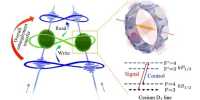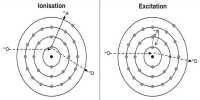When Spice Girls wrote their hit love song 2 Become 1, they probably didn’t have the fluid momentum in mind. However, the title is an appropriate caption for the moment when two liquid droplets characterized in a study published in Physical Review Fluids form a mass together. New imaging techniques, which capture this interaction, could give scientists insight into the super-fast world of stem speed, helping new applications for 3D printing.
Two synchronized cameras, shooting up to 25,000 frames per second, record different angles of stem conversation. Since a dyed drop was sprinkled from a pump, sitting on a slide landing next to a clear stem, both side and bottom allow the researcher to study both the top and internal changes of the stem.
“In the past, for example, there have been two incidents when two drops had an effect and you think they were mixed or one drop just passed over the other,” said Dr. Alfonso Castrejón-Pita, associate professor and co-author of the research, based at Oxford University. In the statement, “Having two cameras and recording droplet interactions from different perspectives answers that question.”
In this footage, the side view camera shows the blue dot sitting on top of the clear blue, where the surface tension between the two prevents them from mixing. More dynamic images can be seen from the images held at the bottom of the slide. As one drop is dropped on another, a surface jet below 15 milliseconds is formed.
“We were able to uncover internal flows, although the filming was fast enough to capture the momentum,” said Dr. Leeds, an associate professor and chief supervisor of the project. Mark Wilson says.
Using this set-up, researchers from the University of Leeds, Oxford University, and the Queen Mary University of London have furthered this research. During the conversation, they saw how the tension on the surface of the trunk changed their behavior. When there was a difference in surface tension between the two droplets, the team observed that surface jets could be increased or suppressed.
Understanding the complexity of stem dynamics provides a better assessment of how the stem is mixed, which the researchers argued is important for the future of 3D printing. Thomas Sykes, a researcher at the University of Leeds and lead author of the paper, said in a statement, “The chemistry behind the evolving 3D-printing technology involves chemical deposits on any surface.” “We often need these chemicals to be located in a very precise way, for example, we would want the droplets to sit side by side or one drop to be in another drop. In other cases, we want to blend them together, creating a desirable response to more complex structures. ” “[This study] has opened a new window on the evolving technology”, developed the techniques in this image, “Dr. Wilson concluded.













